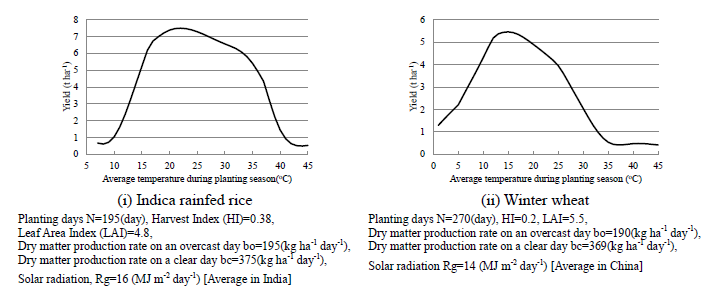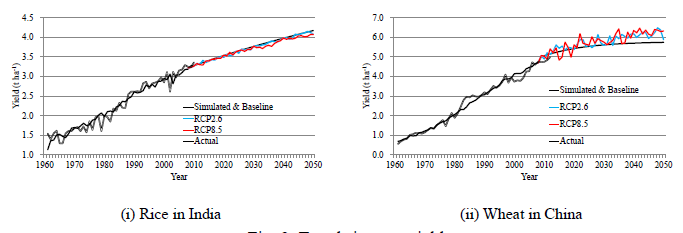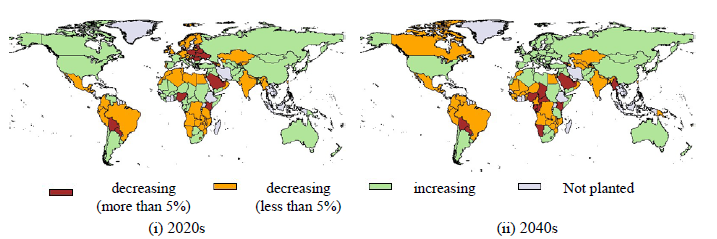Long–term global outlook of crop yields under climate change
Description
A long–term outlook of crop yield is necessary for an economic evaluation of climate change on food supply and demand. If the temperature is lower than the optimum level, the crop yield will increase with rising temperature. Conversely, if the temperature exceeds the optimum level, the crop yield will decrease with rising temperature. The yield function, which considers the inverse U–shaped relationship between temperature and yield, is required for long–term outlook under climate change.
The purpose of this research is to analyze the effects of climate change on major crop yields using yield trend functions, incorporating parameters of yield for climate variables obtained from a crop model. The scenarios used in this research are those of the Representative Concentration Pathway (RCP) in the Fifth Assessment Report (AR5) of the Intergovernmental Panel on Climate Change (IPCC). There are four scenarios, i.e., RCP8.5, RCP6.0, RCP4.5, and RCP2.6, in descending order according to CO2 concentration.
The parameters and functions for 46 crops of the crop model used for analyzing the Global Agro Ecological Zone of the FAO are presented in the report of the International Institute for Applied Systems Analysis (IIASA). The relationship between temperature and yield as indicated in Figure 1 is obtained from the parameters and the functions of the biomass production and photosynthetic rate of the model. These functions are smoothed using cubic spline interpolation.
The target crops are rice, wheat, maize, and soybeans, covering 126 countries or regions, the same number as when the world food model was developed. Data on crop yields were obtained from the FAO (data from 1961 to 2007).
Logistic functions or linear functions with logarithmic time trends are estimated for each crop yield for each country as yield trend functions. Climate parameters of the crop model are incorporated into the trend function.
Climate data in this research are those of the Model of Interdisciplinary Research on Climate (MIROC5), which is a Global Circulation Model (GCM), and these are aggregated for large countries such as China based on the crop cultivation map of the United States Department of Agriculture (USDA).
Figure 2 depicts wheat yields in India and China. The baseline scenario assumes unchanged temperature, solar radiation, and rainfall values during simulation (period 2008-2050). Wheat yield in India is decreased by climate change under the RCP8.5 scenario. Climate change simulation results in China, on the other hand, show substantial fluctuation because the slope of the yield to temperature as indicated in Figure 1 (ii) is steeper than those of other crops.
Figure 3 presents differences in wheat yields between baseline and RCP6.0 scenario during the periods 2021–2030 and 2041–2050. These figures suggest that wheat yields in southern Asian and sub–Saharan African countries will decrease under the RCP6.0 scenario.
Figure, table
-
Fig 1.Relationship between potential yield and temperature -
Fig. 2. Trends in crop yield -
Fig. 3. Effects of climate change on wheat yield: differences between baseline and RCP6.0
- Affiliation
-
Japan International Research Center for Agricultural Sciences Social Sciences Division
- Classification
-
Administration A
- Research project
- Program name
- Term of research
-
FY 2014 (FY 2010-FY 2014)/ FY 2014 (FY 2011-FY2015)
- Responsible researcher
-
Furuya Jun ( Social Sciences Division )
MIERUKA ID: 001740Kobayashi Shintaro ( Social Sciences Division )
- ほか
- Publication, etc.
-
Furuya, et al.(2015), JARQ, 49(2): 187-202
- Japanese PDF
-
2014_A04_A3_ja.pdf286.68 KB
2014_A04_A4_ja.pdf488.14 KB
- English PDF
-
2014_A04_A3_en.pdf252.13 KB
2014_A04_A4_en.pdf309.76 KB
- Poster PDF
-
2014_A04_poster.pdf690.67 KB



